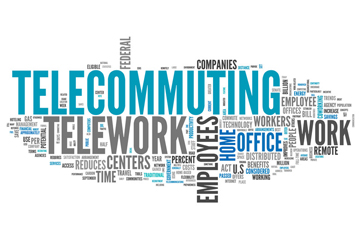
Major companies, including Google and Intel have proved telecommuting can be successful. Well-designed, well organized and well-managed telecommuting programs can offer several benefits to both employees and employers. These include increased productivity, as employees will not have the distractions of an office space, better for the health and the environment of the employees, helps keep older generations in the workforce, reduce operating costs, reduce employee turnover and absenteeism. Teleworkers are more satisfied with their jobs and therefore are more likely to perform better, and stay longer with the company.
Prevalence of Telecommuting
Telecommuting is the future of work. Companies that allow their employees to telecommute are increasing year after year. FlexJobs and Global Workplace Analytics have released The 2017 State of Telecommuting in the U.S. Employee Workforce Report which shows that 3.9 million U.S. employees or 2.9 percent of the total U.S. workforce work from home at least half of the time.
- There has been a 115% increase in telecommuting between 2005 and 2015
- About the same number of women and men telecommute
- Forty percent more U.S. employers offered flexible workplace options in 2017 than did in 2010
Things to Consider before Implementing a Telecommuting Program
Here are some factors to consider before allowing employees to work from home.
- Technology – The success of the telecommuting program is based on the technical support provided to the employees. The organization should provide equipment to telecommuting employees to get work done effectively. The organization should decide who will be responsible for setting up and providing maintenance on the equipment, whether the employee needs to bring the equipment into the office for scheduled maintenance and upgrades, or whether that can be handled remotely. E-mail, web-conferences, phone conferences and internal websites or networks that can be accessed from a remote location also contribute to the success of the telecommuting program. Employers should observe their organization’s IT infrastructure and determine whether their employees will be able to access the information and communicate with other employees, which is necessary to do their tasks.
- Eligibility – The next factor to consider is whether the employee is eligible to work from home. Employers should determine whether the attitude, work ethics and personalities of the employee align with the company’s expectations of telecommuting. Not everyone can be productive when the boss is never around. So, it is essential to ensure that the employee will be successful at executing the arrangement. For that, the employer should consider the past performance of the employee, the nature of the position, how long a person has been at the company or in the role, and how frequently a staff member can telecommute such as full time, once a week, or once a month. In a major company like Xerox, an employee takes a self-assessment to determine if telework is a realistic option, before considering this option. Then the manager will take a similar assessment about the employee and both of them discuss options together. Another major company Aetna evaluates telework options based on three things that include the individual (does the employee have the right capabilities and competencies?), job function (can the work be performed at home?) and home environment (must meet security standards).
- Education and Training – Another factor that the organization should consider must be providing training to managers on how to effectively manage remote staff. It is essential to ensure that managers know how to communicate and collaborate with virtual employees and vice versa. They should understand the soft skills as well as how to use the right technologies to facilitate the desired interaction. It is also important that virtual employees should receive their own type of training.
- Cost – Telecommuting involves costs. The organization should determine whether they will have to pay for an internet connection, a phone connection or mobile phone contract. These costs must be considered before authorizing an employee to telecommute. If it is not cost-effective for the company, then it will not be wise to implement a telecommuting policy.
- Organization should set clear expectations with employees – Employees are required to sign a telecommuting agreement that outlines the various aspects of the telecommuting arrangement. Things that should be included in the telecommuting agreement are:
- The agreed upon telecommuting schedule
- What constitutes an approved remote workspace
- Expectations of availability during core business hours
- Maintaining proprietary and confidential information
- Liability waiver for the organization for loss or damage at an employee’s home
- Requirements for daycare or dependent care during working hours
- Workers’ compensation
- Employee’s approved work-space is considered an extension of the organization and during work hours while the employee is performing work functions, all company policies are still applicable
- Expectations for conducting meetings with other employees and clients
- Employees and managers will regularly revisit the telecommuting arrangement and determine if it is appropriate and effective for the telecommuting arrangement to continue
- Telecommuting is a Privilege – It is important to explicitly state that remote work is a privilege that can be revoked if it is found that an employee is not meeting his or her expectations, while working outside the office. This will notify the employees that certain standards must be maintained in order to continue working offsite.
Considering these factors while developing a telecommuting program will allow the organization to determine if telecommuting is appropriate and help place the parameters around the program that suit the organization.





